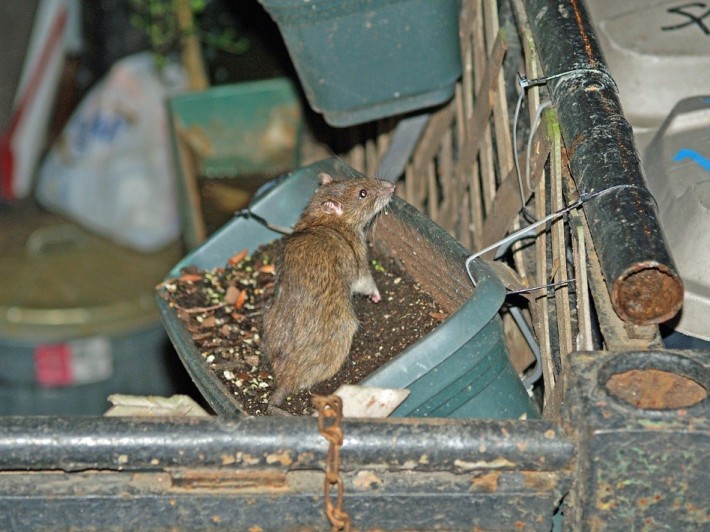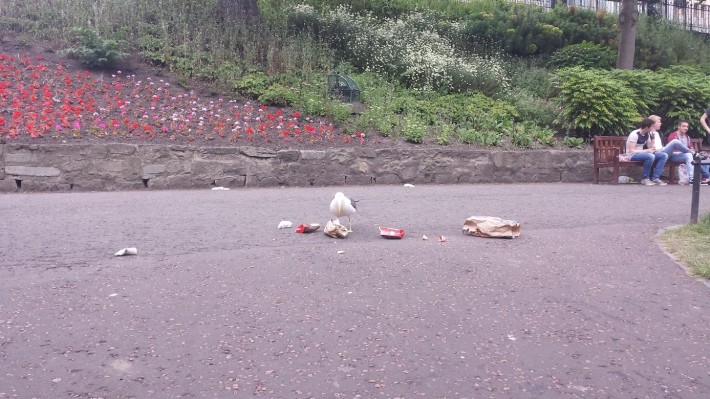by Tora Holmberg
What is common between a human ‘dumpster diver’ and a rodent one? What makes an animal – human or non-human – vermin? How does one cross the boundaries between being integrated into urban ecologies, and becoming disposable as waste: potentially wasted or ‘wastable’? I’ve been dwelling on this puzzle for years, and recently had a chance to discuss it in public when being interviewed for a nationally broadcasted radio program regarding a ‘rat invasion’ into the Swedish capital. The question for the reporter, was ‘why we are so afraid of rats’?

Rat in a flowerbox, New York City (David Shankbone, Wikimedia Commons)
Rats make an interesting case. Rats are highly intelligent, social and flexible. Rats inhabit numerous (human) spaces. They are used and abused for all purposes; loved as pets, fed to other pets (eg. snakes) and cherished in science as iconic experimental animals. Millions, perhaps billions, of rodents are used globally every year in scientific experiments, and much of what we know about ‘human nature’, derives from behavioural research performed with rats. These critters also play important roles as projections of ‘lowly’ human traits, as deceitful, opportunistic, filthy and parasitic. Projections used to downgrade and stigmatize not only rodents, but also various humans. Ethnic groups such as Jews or Roma, and categories such as paperless immigrants and beggars. But rats are also admired as witty survivors, rapidly adapting to any change in the environment. Consequently, a first answer to the reporter’s question is: we are not always afraid of rats. Sometimes encounters create a whole different emotional register. But the question remains: why are urban rats despised and eradicated? And why now?
In the urban jungle, rats—in Stockholm the subspecies of brown rat, Rattus norvegicus—most often live hidden from our sight, in sewers and basements, abandoned greens and deserted alleys. The ‘rat invasion’ that the radio program referred to, emerged as a threat – and thereby scaring – when the apparently nocturnal rodents appropriated certain spaces, like the street and playground park, during daylight hours. They were transgressing spatial-temporal boundaries, shirking circadian rules, and becoming visible. In these well-lit displays of ‘out of place-ness’, they changed the place itself. The street or the park transforms from safe to risky, from clean to dirty, from civilized to unruly. This process has been called ‘verminization’[i], and involves an important affective dimension: boundary crossing, uncanny creatures create fear, disgust, or, in other cases, affection, protection etc.
Another boundary concerns numbers. Urban animals may be tolerated as single; a cat hanging out on a staircase, a few crows or pigeons in the park, and some suburban squirrels or foxes, make up pasture elements that remind human city dwellers of a nature out there (as if the urban space was ever void of nature). But when animals – human and non-human – move together as a masse, they get transformed from individuals to an undefinable colony, a ‘crowd’. The crowd is a multitude of individuals, but act and move as one. A crowd can be either heterogeneous or homogenous, either way there is a close connection between the emergence and control of a crowd and the formulation of a social problem. A widely recognized understanding of the term is that the crowd is defined by its members’ proximity, both materially and through identity politics. But the crowd can also be viewed as a mode, rather than a number of aggregated individuals acting together for a certain goal. If the crowd, like the Stockholm rats, is undifferentiated, then effective bio-political technologies must be able to transform the crowd, and thus reduce the multiplicities, into an identifiable unit. A process through which the rats become vermin and thus killable.[ii] In order to normalize the urban order, ‘sanitation’ is performed, eradicating the rats and restoring human control.
Returning to the trash question I started with, does it matter that the rat invaders live off our garbage? These animals may be viewed as waste workers, as their livelihood depends on the stuff we throw away. Rats and other waste workers, collect and transform the unwanted remains of human consumption. As the rats in Stockholm are getting too many, too visible, too tame, the pest fighters—as a second order waste workers—dealing with eradicating these wastable animals, have an economic upturn. Contemplating rats and verminization, it’s worth thinking further about other contemporary examples of illegitimate as well as legitimate waste management. A while ago the news reported about local supermarket employees, who routinely urinated on dumpster food waste in order to hinder people from recycling it.
We can learn a lot about a society’s structure, norms and values, by studying waste management and the treatment of human as well as non-human waste workers. The normal urban pattern in the North, is that visible garbage—like household waste or litter on the street—gets cleaned up, made invisible, and disappears into the urban metabolism, through legitimate waste work. This invisible, already wasted, is in turn taken care of by illegitimate waste workers like rats and other dumpster divers, challenging this normal order. When transforming and elevating waste into something useful—food, nesting material or other valuable units—the order otherwise taken for granted, gets highlighted. By urinating on food waste or poisoning the rats, we say ‘do not touch my consumption’. Rats may force us to reconsider what is considered waste, but also what and who can be discarded.

Gulls in Edinburgh (Tora Holmberg)
[i] Holmberg, Tora. 2015. Urban Animals. Crowding in ZooCities, Routledge: London.
[ii] Haraway, Donna. 2008. When Species Meet, Minnesota University Press: Minneapolis.